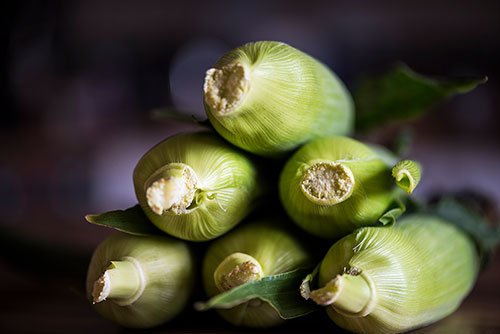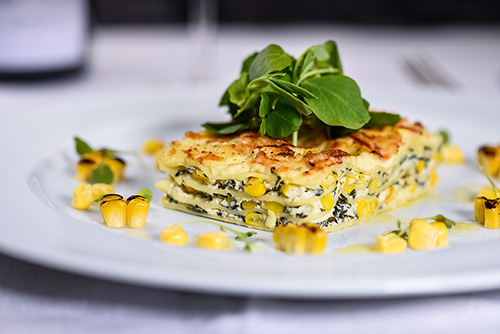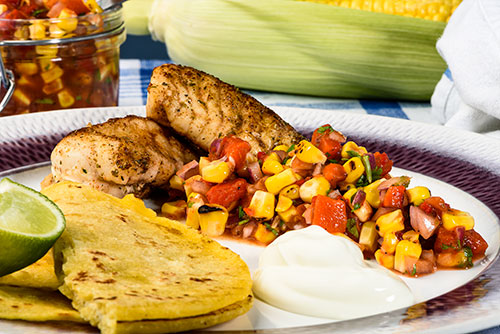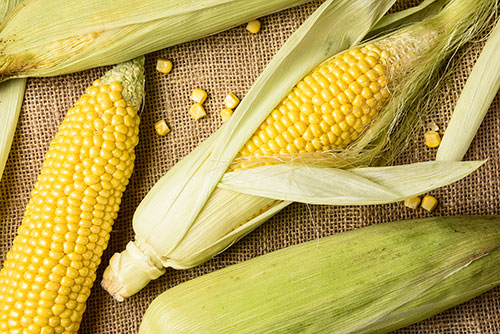Home-grown harvest: Sweetcorn
Perfect for late summer nights, sweetcorn can bring a pleasant sugariness to a meal or be milled down to create corn tortillas. Former Sienna chef-proprietor Russell Brown makes some recipe suggestions
Golden yellow cobs of sweetcorn immediately bring to mind late summer barbecues, the cobs charring in their husks over the flames. However, the sweet, crisp kernels certainly have a bigger role on the menu than that.
Corn is a member of the grass family and the variety originally cultivated would have been field corn; the other varieties are popcorn, ornamental corn and sweetcorn. It has been eaten for thousands of years, with a history encompassing the Aztec, Maya and Inca civilisations.
Sweetcorn differs from field corn in that it has a spontaneous gene mutation which causes the kernels to accumulate about twice as much sugar and significantly less starch. Today, several hundred sweetcorn varieties are available. The sugar in corn begins to convert to starch as soon as the ears are picked, but the modern "supersweet" varieties have a negligible sugar-to-starch conversion and are significantly sweeter to start with. Depending on the use, these can actually be over-sweet.
It can be found in three different colours, the familiar yellow, white and a bi-colour cob. Across the EU, around 70,000 hectares of sweetcorn are grown, with Hungary being one of the largest producers.
Probably the most widely known product made from corn is cornflakes, which are made of milled corn, sugar, salt, barley malt extract and minerals. Milled corn is also widely used in tortillas, tacos, polenta, bread and grits.
Sweetcorn is eaten as whole cobs or the kernels are removed for use in fritters, pancakes, soups, salsas and breads. The kernels can also be puréed and make a good accompaniment to shellfish and light game such as partridge. As a purée, the corn can also be used for ice-creams, panna cottas and in cake batters.
At the Olive Tree restaurant in St Merryn near Padstow, the chefs are using sweetcorn purée with seared scallops, and Chantelle Nicholson, chef-patron at Tredwell's in London, is cooking a cod dish with sweetcorn, cornbread, Little Gem lettuce and aïoli.
The season in the UK runs from late July at its earliest through to mid October and the cobs are widely available. The crop has been grown commercially in the UK for many years and a number of varieties are grown to give continuity through the season. The main growing areas for commercial crops of sweetcorn, as opposed to maize which is widely grown as a fodder crop, are in Sussex and on the Isle of Wight.
Buying and storage tips
- Buy corn as fresh as possible for the sweetest flavour
- Cobs in the husk will keep longer
- Keep cobs refrigerated to reduce the conversion of sugar to starch
Sweetcorn and ricotta lasagne
Serves 8 as a starter
For the lasagne
- 250g spinach
- 500g ricotta
- 2 cobs of sweetcorn
- 20g unsalted butter
- 5g Dijon mustard
- Juice of half a lemon
- 200g cream cheese
- 100g double cream
- 12 blanched lasagne sheets
- 50g grated Parmesan
- Maldon sea salt and fresh black pepper
Sauté the spinach in hot olive oil with a little salt and black pepper. Drain and chill. Blend the ricotta in a food processor and season. Roughly chop the spinach and mix this into the ricotta. Cut the kernels from the sweetcorn cobs, heat the butter until it turns nut brown, then sauté the corn briefly in the brown butter. Spread onto a cold tray and cool. Add the corn to the spinach mix. Season well and add the lemon juice and mustard. Warm the cream cheese and cream together and season to taste.
Line a 30cm x 22cm bakewell tin with foil and place three of the lasagne sheets in the bottom, overlapping them slightly. Spread a third of the ricotta mix over the lasagne and top with three more sheets of the pasta. Press down gently to give a smooth surface. Repeat twice more with the remaining pasta and filling.
Pour the cream cheese mix over the top layer of pasta and sprinkle on the Parmesan. Bake at 160°C for approximately 20 minutes until the dish is hot and the top is golden brown. Allow to cool for 10 minutes and then cover with a sheet of clingfilm and press gently with a second tin. Chill completely. Remove from the tin, trim the edges and divide into eight portions.
To serve
- 80g corn kernels
- 40g rocket or watercress
- Micro rocket
- 2tbs lemon dressing
Place a portion of the lasagne on a piece of silicone paper, seal in a plastic container and warm in the microwave. Slide the lasagne out of the box onto a tray and finish under the grill.
Mix the corn with some dressing and dress the leaves. Place the lasagne in the middle of the plate and top with the salad. Spoon the dressed corn around the plate and add some micro rocket.
Blackened monkfish with charred corn and roasted red pepper salsa
Serves 4
- 8 x 60g pieces of monkfish, trimmed and all membrane removed
For the salsa
- 1 cob of sweetcorn
- 1 red pepper, roasted, skinned, deseeded, diced
- 1 small red onion, finely diced
- 1 red chilli, charred, skinned and chopped
- 50ml tomato passata
- Juice and zest of 1 lime
- 50ml rapeseed oil
- Maldon sea salt and fresh black pepper
- 1tbs chopped coriander
Lightly oil the corn cob and season with salt. Char it on a chargrill, barbecue or griddle pan. Allow to cool and cut all the kernels from it. Mix the remaining ingredients, except the coriander, and allow to sit at room temperature for an hour. Check the seasoning. If the salsa is very wet, strain off the liquid and thicken with some Ultratex. Just before using, stir in the coriander.
For the blackened spice mix (recipe courtesy of Ben's Cornish Kitchen, Marazion)
- 1tsp coriander seeds
- 1tsp cumin seeds
- 1tsp cayenne pepper
- 1tsp smoked paprika
- 1tsp cracked black pepper
- 1tsp Maldon sea salt
- 1tsp garlic powder
- 3tsp herbes de Provence
Toast the seeds and then grind all the ingredients together in a pestle and mortar.
For the corn tortillas
- 160g masa harina/cornmeal
- 40g white bread flour
- 8g finely ground Maldon sea salt
- 140ml water, approximately
Sift the cornmeal, flour and salt together, then gradually mix in the water to form a soft dough. Knead for a few minutes and then cover and rest for 30 minutes in the fridge. Divide into eight balls and press or roll into 12cm discs that are around 3mm thick. Use an opened up polythene bag that is lightly oiled to stop the discs sticking. Transfer the tortillas to squares of silicone paper.
Cook the tortillas for around one minute on each side on a hot griddle or in a heavy non-stick frying pan. They should be dry and have light brown spotting on each side.
Wrap the cooked tortillas with a clean towel while you cook the remainder; this causes an amount of steam which will help to soften the tortillas.
To serve
- 4dsp sour cream
Press the monkfish pieces into the spice mix to give an even crust. Heat some oil in a non-stick pan and fry the monkfish on the crusted side. Add some unsalted butter and baste, then flip the fish over and finish in a hot oven if necessary.
Drain the fish on some paper towel and plate with a generous portion of the salsa and two corn tortillas. Finish with a spoonful of sour cream.
Market report
The British sweetcorn season runs from mid-August to mid-October. European sweetcorn starts in early July with supplies from Spain then France.
Expect to pay 30p to 50p per ear for British sweetcorn.
Charlie Hicks
Coming soon
Over the next few months I will be featuring beetroot and cauliflower in Home-grown harvest. Do let me know how you use these products on your menus and what your seasonal favourites are. Email recipes, dish suggestions and photographs to:
russell@creativeaboutcuisine.com
Russell Brown
Russell Brown ran the Michelin-starred, three-AA-rosette Sienna restaurant in Dorchester, Dorset, for 12 years with his wife Eléna. He now runs his consultancy business Creative about Cuisine. He specialises in restaurant consultancy and photography. www.creativeaboutcuisine.com




















